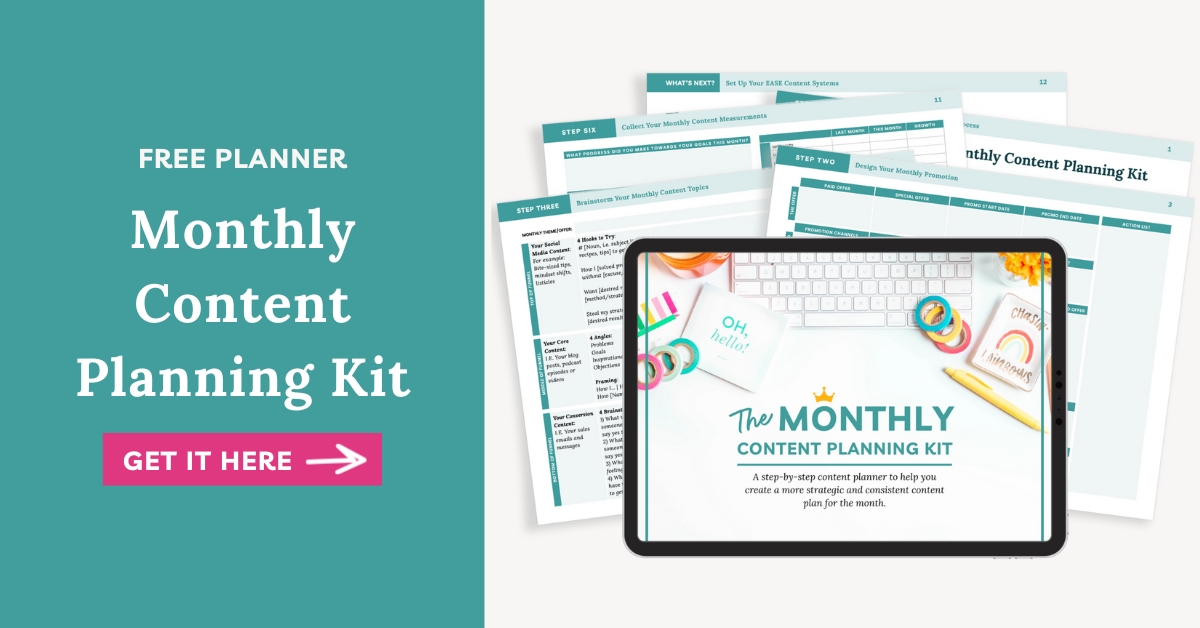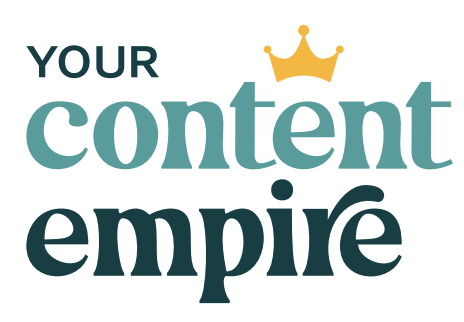Do you have a monthly membership that you’re struggling to get new members in? Or maybe you have a steady stream of new members, but you want to scale it so you have a higher monthly recurring revenue? In this video, I’m giving you the ultimate monthly marketing plan for memberships—all done for you.
Prefer to watch instead?
Want to listen on the go?
Memberships are one of my favourite business models from a content standpoint. There’s so much opportunity to overlap your work inside the membership with what you’re sharing publicly to generate interest and leads for that membership.
This strategy that I’m covering comes from the last few clients I’ve coached who have memberships but were really struggling to balance creating content for that membership and marketing it externally.
This works best for memberships that have either monthly content that’s being released or themes for the month that they’re covering – even if it’s something that cycled through.
For instance, one client is fractional CFO who just crossed the 6 month mark for his membership (yay!) and he launched that membership as a way of getting to work with and support more business owners than just the ones who he had capacity to work with one on one. Every month, he hosts a masterclass on a particular theme, that leads into a challenge for implementing that theme and then a coworking session for a space and place for members to get support and take action. The themes of the challenges and masterclasses are things like: your monthly bookkeeping system, how to forecast your expenses and income, how to build a paid ad system that makes sense from a ROI perspective, tax prep finish line. The plan for next year, is to run these same themes in the months where they make the most sense even if he’s adding a few bells and whistles that second time around. What’s nice is that it means most of his work and time investment for the membership is relegated to year one.
But that stills leaves us with the challenge of (1) how to market your membership; and (2) how to do it in a way that leverages the content you’re creating internally for your members without giving everything away.
Let’s tackle those challenges head on ↓
The Monthly Marketing Plan for Memberships Strategy
Structurally, the strategy is pretty simple.
Every month, you’re going to work on the content for the next month in your membership. Whether that’s a masterclass, a challenge, templates, a mini course or some combination of these.
You’ll start by picking the theme or topic for the upcoming month.
Then, as you’re working on that membership content, you’ll also prepare teaser content to share externally in weeks 1-3 of the month. This is so you can “gather” anyone who’s interested in that particular theme or topic from your audience AND add new people to your audience who are interested in that theme as well.
Then, in week 4, you switch your messaging from free, value content to inviting them to join the membership so they can dive deeper into the theme and get whatever related results they most desire.
What I love most about this method is that it perfectly supports the cycle of a membership and helps you from having to context switch when creating content for your internal and external audiences. The scope may be different but you’re able to stay on theme.
Content Planning
The first thing we have to do though is plan your topics. How do you create external content on your theme without giving everything away?
Well, step 1 is to choose your theme of the month.
Here are some examples:
- A health membership with a month on hydration, or cutting sugar or hitting 10K steps.
- A membership for coaches with a month on coaching skills, or a month on setting up your onboarding systems.
- A Facebook ads membership with a month on micro offer ads, a lead gen ad system or adding thank-you page offers.
- Lots of different options. And remember, sometimes the process of designing a membership curriculum is similar to designing an e-course. If your membership were a course, what would the “modules” be?
After you have your theme for the month chosen, and this assuming, you already know what’s included in your monthly membership and how the theme is delivered (is it a workshop? is it a challenge? is it templates?)
But after you have your theme, it’s time to brainstorm your external content so you can work on and publish it while continuing to work on the membership content for the next month.
Here’s what I recommend: Take the topic or theme and brainstorm the following:
- PROBLEM: What is a common, very annoying, problem related to this theme that your audience struggles with? Helping people solve or reframe this problem is your content topic for week 1. The goal is to attract and appeal to people who are problem-aware.
- Next GOAL: What is a common, very desirable, goal related to your theme that your audience wants to achieve badly? Then think of a smaller “pre-goal” that’s just as desirable that they’ll have to reach before the ultimate goal. Helping people achieve, get clarity on or reframe that goal is your content topic for week 2. The goal is to attract and appeal to people who are solution aware.
- Finally, OBJECTION: What is a common, very legitimate, excuse about why they believe they won’t be able to acheive their goals or solve their problems related to this theme? Resolving, tackling or reframing this objection is your content topic for week 3. We’re moving people towards the product-aware and ready to buy stages through addressing this objection.
Next it’s time to prep your content ↓
Week 1
Think of week 1 of the month as your thematic kick-off. The entire goal of the first 3 weeks is to generate interest in your membership from anyone who’s a good fit based on their interest in the topic you’ll be covering in the membership in the following month. What’s great about that is that it means, every single month as you’re introducing new themes, you’ll have an opportunity to appeal to an entirely different segment of your list who is drawn to that particular theme.
In terms of core content, you’ll create a long-form blog post, podcast episode or video on the PROBLEM you brainstormed in the earlier step we covered.
Your social content can be pulled from this long-form post but should all be focused on the problems related to the upcoming membership theme.
And if you feel like getting fancy, a good addition to this three weeks of content is to have some kind of freebie related to the theme that people can sign up for you if they’re interested in it. You can use this as the call to action on your long-form content. It’s a good way to make sure you can get back in touch with anyone who has expressed interest in the theme when you switch to “selling” in week 4.
Let’s go through a few examples of problem posts:
- A problem post for the health membership’s theme of hitting 10K steps could be: The hidden costs of sedentary lifestyles OR how to find time to sneak in your steps when you’re busy
- For the coaching membership with a month of setting up an onboarding system for new coaching clients, the problem post could be around: Why not having an automated onboarding process is costing your money and referrals
- Finally for the Facebook ads membership with a monthly theme of micro-offer ads, the problem post could be something like Why freebie ads aren’t getting you the right leads
Week 2
So that’s week 1. With week 2, we’re shifting into focusing on the people who are now solution aware. They know they have a problem they want solved. They know what the solution to the problem is (and it’s aligned with how you solve it).
For your long-form content, you’ll create a written blog post, podcast episode or video on the GOAL you brainstormed in the earlier planning step.
Just like before your social content can be pulled from this long-form post and your call to action for the long-form content is ideally going to be that simple PDF related to the theme. Think something simple like a cheat sheet, journaling sheet, planning sheet, etc.
Let’s cover some examples:
- A goal post for the health membership’s theme of hitting 10K steps could be: How to pick the right walking shoes for you, X ways to sneak in extra daily steps
- For the coaching membership with a month of setting up an onboarding system for new coaching clients, the goal post could be around: How to pick the right onboarding tool for your coaching clients
- Finally for the Facebook ads membership with a monthly theme of micro-offer ads, the goal post could be something like how to choose your micro-offer topic. See a small goal related to bigger theme that kind of prepares them or gets them ready to join the membership.
Week 3
Moving on to week 3, this is usually the last week of “interest generation” content before shifting into sales invitations.
The long-form content this week is based on the OBJECTION topic you brainstormed in the planning phase.
Some examples:
- For our health membership’s theme of hitting 10K steps the objection post could be: How to gradually increase your daily steps if 10K a day feels too hard right now. The excuse or objection is “feels to hard right now.”
- For our coaching membership with a month of setting up an onboarding system for new coaching clients, the objection post could be: Why automating your onboarding process for new clients will actually save you time. The objection this addresses is “it’ll take too much time to set this up.”
- And for our Facebook ads membership with a monthly theme of micro-offer ads, the objection post could be: How to start your micro offer ads with a tiny budget. The objection addressed is “I have a tiny ads budget.”
Week 4
After you’ve run these three weeks, you should have a really good idea of who in your general email list is interested in this theme. You should have also added new leads onto your email list from those who are interested in this theme. Now that we know who these folks are, it’s time to invite them to your membership.
We want to position this invitation as, “hey you’re interested in X. Next month in the membership, we’re focused on X to help you achieve these 3 results… then list them.”
You might have a special bonus or pricing to entice people to join right away, but you also don’t necessarily need that either as there’s a built-in urgency to get in before we start this journey in the membership based on this theme I’m interested in learning about.
I’d recommend 3-5 days of sales emails (1-2 per day) and daily social media posts.
- Day 1 can be announcing the membership theme of the month
- Day 2 can showcase a member who achieved a result related to the theme
- Day 3 can talk about HOW you’re going to help members achieve results
- Day 4 can be addressing a common objection to joining the membership
- Day 5 can be your last call to join before we begin message
Adding On New Strategies for Monthly Marketing Plan for Memberships
The one thing I want to encourage is for you to view this marketing strategy as more like a monthly system. You can fine tune and streamlined things AND you can layer on additional strategies and optimizations.
The first time you run this system, keep it simple. There’s going to be so much figuring out that it might be overwhelming at the start.
Then each time you run it, you can ask yourself what you could either test or add in.
Here are 10 potential strategy layers for your membership marketing plan: (although there’s a whole lot more than these)
- Interviews with members
- Affiliates
- Abandoned Cart Email
- Optimizing the salespage with a timer, chat widget, proof widget, heat mat
- Add-ons and upsells
- Retargeting ads
- Running a free challenge or workshop on the theme
- Adding a special limited-time bonus or free gift for joining
- Additional social media posts (especially stories or posts on platforms with warm audiences following you)
- Downsells
Those are just some quick ideas to get your wheels turning.












